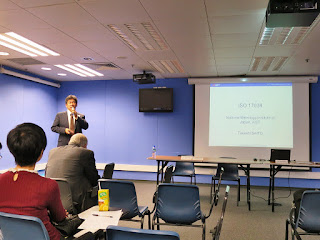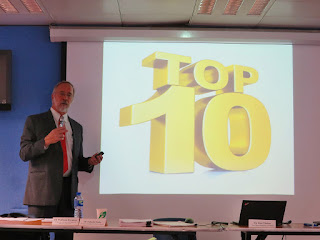Hong Kong Accreditation Service
(HKAS) organized a training course entitled “Training on RMP and PTP
Accreditation” on 11 Nov 2016. ISO
17034, the future standard for the accreditation of reference material producer
(RMP), is expected to be published soon.
Many other ISO guides and standards relevant to RMP and proficiency
testing provider (PTP) operation have also been revised recently or are under
review. This training course aimed at
enabling participants to gain a better understanding of the new
requirements. Before the start, I met my
old friend Mr. K. Gabuji (Technical Assessor and Lab Test Expert) and took a
photo for memory.
In the beginning, Dr. Wolfram
Bremser (BAM Federal Institute for Materials Research and Testing) was the
first speaker and his topic entitled “Competence of RMP and the transformation
of ISO Guide 34”.
Dr. Bremser said CRM needed for
legal and contract regulations setting.
It could be used for External and Internal Control. Then he briefed the development of that
standard on the transformation of ISO G34 into an international Standard by
REMCO and cooperation with CASCO since July 2014.
After that Dr. Bremser showed the
ISO/FDIS 17034 “Conformity assessment – General requirements for the competence
of reference material producers” structures to us as follows:
1.
Scope
2.
Normative reference
3.
Terms and definitions
4.
General requirements (4.1 Contractual matters; 4.2 Impartiality; 4.3
Confidentiality)
5.
Structure requirement
6.
Resource requirement
7.
Technical and production requirements
8.
Management system requirement
Annex A – Summary of production
requirement for reference materials and certified reference materials
The requirements to RM and CRM
were discussed in clause 7.1.1 and 7.1.2.
Finally, Dr. Bremser mentioned
the structure requirement of RMP such as legal status, management system, roles
and responsibilities, etc. In Management
System Requirement, Option A was to maintain a documented management system and
Option B was based on ISO 9001 and to fulfil ISO 17034 requirements. For internal audit, it was according to ISO
17025 and ISO 17034. At the end, he
stated the rules and procedures of corrective actions and customer relations.
Dr. Takeshi Saito (National
Metrology Institute of Japan) was the second speaker and his presentation named
“ISO17034”. Firstly, Dr. Saito stated
the definition of RM and CRM based on ISO Guide 30:2015.
2.1.1 Reference material (RM) – sufficiently homogeneous and stable
with respect to one or more specified properties, which has been established to
be fit for its intended use in a measurement process
2.1.2 Certified reference material (CRM) – RM characterized by a
metrologically valid procedure for one or more specified properties, accompanied
by an RM certificate that provides
the value of the specified property,
its associated uncertainty, and a
statement of metrological traceability.
Then Dr. Saito explained What,
When, Why, Who and How about reference material (5W1H).
What? ISO Guide 30:2015 and
ISO/IEC Guide 99:2007 has an analogous definition (5.13)
When and Where? Checking
performance and Calibration of measurement instruments; Method Validation,
Characterization of materials and establishing Metrological Traceability
Why? Monitor consistency, QC,
Reliability of measurement results, etc.
Who? Lab Analysts, Researchers,
etc.
How? ISO Guide 33:2015 “Reference
materials – Good practice in using reference materials”
After that Dr. Saito briefed ISO
17034 which was prepared by the ISO Committee on Conformity Assessment (CASCO),
in collaboration with the ISO Committee on Reference Materials (REMCO). The first edition of ISO 17034 canceled and
replaced ISO Guide 34:2009 which had been technically revised. Dr. Satio introduced some major changes which
had been made compared with ISO Guide 34:2009 including 6.1 Personnel, 6.2
Subcontracting, 7.2 Production planning, 7.3 Production control, 7.4 Material
handling and storage, 7.6 Measurement procedures, 7.7 Measuring equipment, 7.8
Data integrity and evaluation, etc.
Dr. Wolfram Bremser (BAM Federal
Institute for Materials Research and Testing) continued the topic on “ISO 17034”. He discussed the data integrity and
evaluation that computer software developed in-house or off-the-shelf software
further developed for specific use is validated and shown to be adequate for
use. (Remark: The training for
Validation of Computer Systems cost USD 1755!)
Then he discussed the assessment
of homogeneity, assessment and monitoring of stability, characterization, as
well as, assignment of property values and their uncertainties of RM.
After that lunch, Dr. Takeshi
Saito (National Metrology Institute of Japan) presented the topic entitled “Revision
of ISO Guides 30, 31 and 33”.
ISO Guide 30 – Reference material
– Selected terms and definitions
ISO Guide 31 – Reference material
– Contents of certificates, labels and accompanying documentation
ISO Guide 33 – Reference material
– Good practice in using reference materials
(ISO Guide 32 – Calibration in analytical
chemistry and use of certified reference materials (Obsoleted and revised by
ISO G33))
Dr. Saito showed the diagram
about ISO/REMCO related guides and others (in which ISO 17034 would replace ISO
Guide 34). Then he also mentioned the
good practice in using RM and CRM in ISO Guide 33. He introduced 6 common forms of RMs as
follows:
a)
Pure substances
b)
Standard solutions and gas mixtures
c)
Matrix reference materials
d)
Physical-chemical reference material
e)
Reference objects or artefacts
(P.S. period of validity <
lifetime)
Dr. Saito also discussed the
relevance to the measurement system below.
a)
Level; need to cover target level (e.g. concentration)
b)
Matrix; need to be similar matrix
c)
Form; should be used in the same form
d)
Minimum sample intake; need a sub-sample representative of the bulk
e)
Quantity; sufficient for the entire experimental programme
f)
Stability; instruction for handling and use of the RM certificate is
important
g)
Acceptable uncertainty of the certified value
h)
Commutability
At the end, Dr. Saito demonstrated
the sample CRM certificate to us.
The last speaker was Mr. Dan
Tholen (Dan Tholen Statistical Consulting) and his topic was “Statistical
approaches in reference material production and proficiency testing: ISO Guide
35 and ISO 13528”. Firstly, he briefed
the definition of Proficiency Test (PT) items as follow:
- Sample, product, artefact, reference material, piece of equipment,
measurement standard, data set or other information used to assess participant
performance in proficiency testing
Then Mr. Tholen briefed top ten
changes of ISO 13528.
10. Invalid/obsolete techniques removed – ISO
13528 (Remove obsolete requirement – ISO Guide 35)
9.
Symbols consistent with proper statistical protocol – PT (Terms
consistent with proper statistical protocal – RM)
8. Could not resolve all issues -
ISO 13528 (Could not resolve all issues in Guide 35)
7. Guidance on PT evaluation with
Total Measurement Error (Guidance on RM stability due to usage conditions)
6. Can use z’ with consensus mean
and standard deviation (More flexibility in CRM characterization)
5. Align ISO 13528 and ISO Guide
35 (ISO 13528 / Guide 35 components for uncertainty of the assigned value)
4. Allow Robust techniques
3. Flag questionable participant
uncertainties in PT (ulab) (Guidelines on questionable components in
CRM)
2. New Statistical Model for PT
(Guide 35 additional statistical designs: Balanced nested designs, Randomized
block designs, Accelerated & Isochronous stability study)
1. PT: Link statistical methods
to objectives for the PT scheme
Finally, Mr. Tholen said the
choices in ISO 13528 and ISO Guide 35 made PT providers and RM producers look
like a supermarket, but accreditation bodies needed to assess whether the
chosen procedures are appropriate to provide a competent assessment of statistical
methods. He also showed us the standard
and discussed “small numbers of participants”, “identifying outliers” and “statistical
expertise”.
Reference:
















沒有留言:
發佈留言